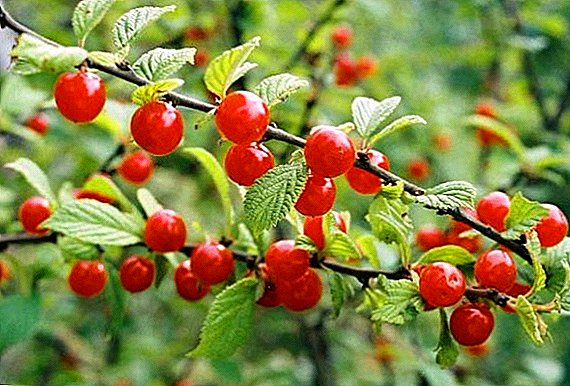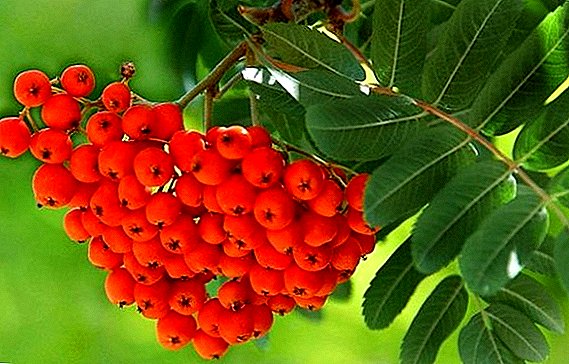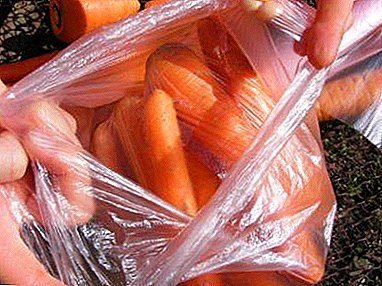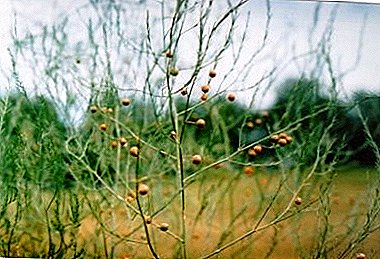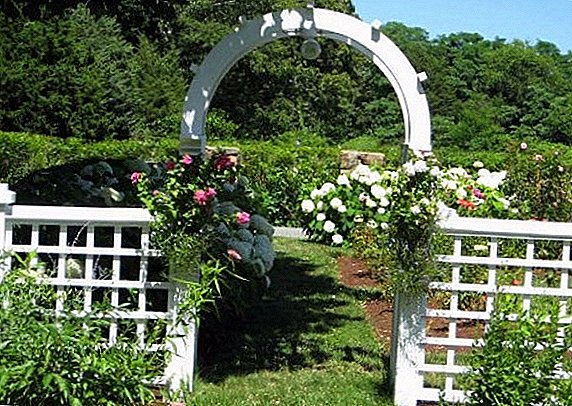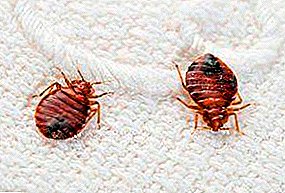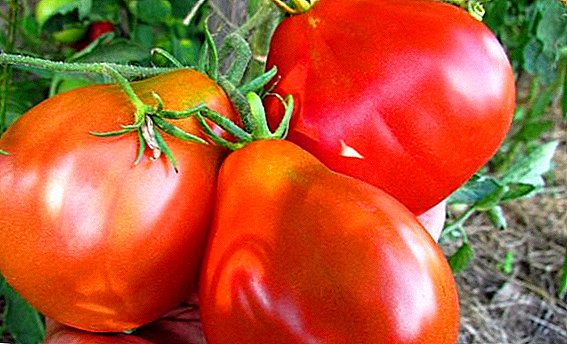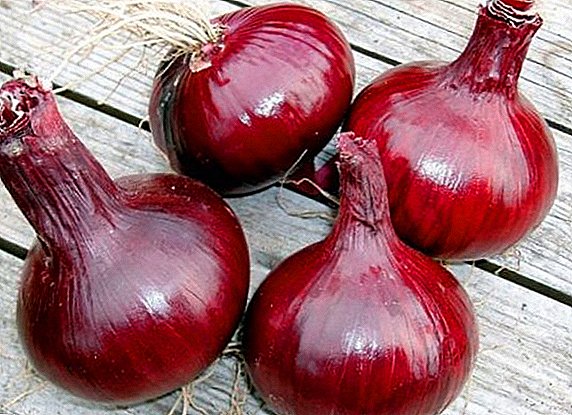 Onions rightfully occupy an honorable place among the most common vegetable crops on the planet, because it is often used in cooking. There are over a thousand kinds of onions, and they all differ in taste and appearance.
Onions rightfully occupy an honorable place among the most common vegetable crops on the planet, because it is often used in cooking. There are over a thousand kinds of onions, and they all differ in taste and appearance.
Among these varieties of varieties, Carmen onions stand out due to their sweetish taste and bright red scales.
Variety description
Onion "Carmen" (it is also called "Red" because of the red-brown color of the flakes) is a two- or three-germ variety, has medium dense, rounded flat bulbs, each with an average weight of 55-75 g. 
Under the top husks, the turnip has a dark red or purple color, and the inner flesh is bright white with purple stripes. The plant grows to 30-35 cm.
Find out what is useful for red onions for the human body, as well as about the peculiarities of growing Yalta onions.
There are distinctive features of Red onions from other varieties:
- yield directly depends on agricultural technology and soil quality;
- vegetable can be cultivated for two seasons, in several stages;
- Onions have a milder taste and juicy fibers compared with yellow varieties.
We list the benefits of onion "Carmen":
- fruits with a semi-sharp taste and pronounced sweetness;
- turnips have good keeping quality and can be stored for up to 9 months under the right conditions;
- the variety has one hundred percent maturity;
- high yield.
Culture has some drawbacks in growing:
- does not tolerate a lack of sunlight, which can cause fungal diseases;
- variety demanding on the composition of the soil.

Did you know? The bow accompanies man throughout history: it is mentioned in ancient papyrus found in Egypt, and medieval warriors had the belief that the bow could protect from sword strikes, so they took the onion with them on the battlefield.
Characteristics of onions and yield
Onion "Carmen" is very healthy because of the high content of ascorbic acid in it: fresh turnips contain from 4 to 19.5 mg of vitamin C. Due to this, it is recommended to use vegetables fresh in salads.
Here are some of its characteristics:
- “Red” is saturated with volatile production, sugars, dry substances that help the body fight viruses and colds, as well as bad cholesterol and the formation of cancer cells.
- As for yield, this variety is considered early maturing, with a ripening period of 60-90 days when planted with seeds and 45-50 days - seedlings. The upper husk on the turnips begins to turn yellow after 100 days from the time of planting.
- "Red" is a high-yielding variety: 1.5-2.5 kilograms of onions can grow on one square meter, and up to 180 centners can be removed from one hectare.
- This variety is grown onions annual and biennial crop.

Selection of planting material
There are different calibrations of onion sets: from 8 mm to 40 mm.
The size of the bulbs depends on the type of planting:
- 8-14 mm - for winter planting;
- 14-21 mm - for sub-winter (the best size for spring planting);
- 21-24 mm and 24-30 mm - podzimny landing on the feather and for early maturation;
- 30-40 mm - only for green.
Recommendations for choosing onion sets:
- On the package with onion sets, the date of packing, the period of storage and the period of planting shall be indicated.
- Onions should be smooth in color, free from specks, dense, dry and free from damage.
If you purchased onion sets a little damp, it must be dried, scattering in a single layer. 
Did you know? The bulb owes its specific taste and sharpness to sulfur compounds, and sulfenic acid, which is part of it, participates in the formation of a substance that causes tears.
How to choose seeds:
- It is best to buy onion seeds at the end of winter: during this period their cost is much cheaper than if it is done in spring.
- Planting material is recommended to buy only in a specialized store, making sure that it is licensed, and also to check the certificate of quality.
- Packing with seeds must be intact, with no signs of wet or damage.
- On the bag should be an image of the fruit, which coincides with their appearance during harvest.
- On the packaging should be indicated shelf life of seeds: the fresher planting material, the better its germination.
- It is necessary to carefully study the description of the variety on the package, since they sell two types of onion in the distribution network: the middle-seasoned variety "Carmen" and the middle-seasoned "Carmen MC". The descriptions of both species and their taste are identical, although Carmen MC has white streaks.
- Attention should be paid to the onion recommended by the manufacturer and the type of soil suitable for it.

Growing conditions
Necessary conditions for growing onion "Carmen":
- open and sunlit areas are best for onions of this variety;
- the soil on the beds should be loose and nutritious, moderately wet;
- for the growth of culture requires reduced air humidity;
- good seed germination is possible at a temperature of + 15 ... +17 degrees;
- good aeration and constant weed control are needed;
- during cultivation, strict observance of the rules of crop rotation is necessary.
Soil and fertilizer
Soil for growing crops should be neutral, with low acidity. 
To neutralize acidity, the following steps are needed:
- Late autumn to make a bed of humus.
- In the spring, after the snow melts, sprinkle the area with wood ash or apply a solution of copper sulphate to the treatment.
- Neutralize acidity with limestone.
You can not plant onions for two years in a row on one site (the recommended aging period is 3-4 years). Unsuitable predecessors - garlic.
The following cultures can be suitable precursors:
- cucumbers;
- White cabbage;
- tomatoes;
- legumes;
- carrot;
- corn.
Important! Litmus test will help determine the acidity of the soil in your area. To do this, make a small hole in the soil, pour water there and let it soak a little. Then put a litmus in a puddle, and if it changes color, it means that the soil in the area is acidic.

Growing from seed to seedlings at home
In order to obtain seedlings for planting, seeds are sown in closed ground in the first decade of February. Consider in detail the process.
Seed preparation
Before sowing nag it is necessary to prepare. If you skip this procedure, the seedlings can appear only on the 20th day, the prepared seeds will ascend in a week.
Seed preparation before sowing is as follows:
- Soak the seeds in warm water and leave for a day.
- Disinfect in a solution of weak potassium permanganate. You can soak the seeds for 12 hours in 0.01% boric acid.
- Rinse the seeds in clean water.

Content and location
Onion seedlings are grown on warm window sills or heated, glazed balconies, where there is a lot of sunlight. It is desirable that it was the south or southeast side.
For planting seeds, you can use the following capacity:
- small drawers;
- narrow mesh cassettes.
Seed planting process
The seed planting procedure is as follows:
- Fill the soil in the tank.
- Pour the ground for disinfection with a weak solution of warm potassium permanganate.
- Make grooves with a distance of 5-6 cm in the box, small recesses in the cells.
- Sow the seeds to a depth of 1.5 cm and level the ground.
- In boxes the seeds are sown thickly, in the cells - one by one seed.
- Pour water at room temperature from the spray can.
- To create a greenhouse effect, cover containers with foil.
- Arrange additional lighting with a fluorescent lamp.
- The temperature mode of cultivation is not lower than +20 degrees.

Did you know? In the East, since ancient times they knew about the healing properties of the bulbs and prepared from them a lot of drugs. No wonder the eastern saying says: "Hugging a bow, get rid of disease."
Seedling care
Onion shoots appear after about 6-8 days.
Care of them is as follows:
- Watering moderate, warm water, carried out as the soil dries.
- Before planting, seedlings are fertilized twice with fertilizer purchased from a specialty store or cooked by themselves (1 g of nitrate per 1 liter of water or 5 g of potassium chloride + 20 g of superphosphate + 10 g of urea diluted in 10 l of water). For the first time, seedlings are fed on the 20th day after germination, and then - in two weeks. After the feeding procedure, you should wash the solution with clean water from the green onions.
- For good aeration, it is necessary to carefully loosen the soil the next day after watering.
- Usually, the soil in which black nipples are sown contains weed seeds. It is necessary to regularly remove them so that they do not absorb nutrients from the soil and do not drown out the seedlings.
- It is necessary to shorten the seedlings in the growth stage of the third leaf by 2/3 of the height in order to prevent lodging of seedlings.
- The room with seedlings must be aired daily for a short time (5-10 min.).
- Seven days before planting in open ground, it is necessary to harden the seedlings: increase the ventilation time, reduce moisture and take out the onion seedlings to the open air for 30 minutes at a temperature not lower than +10 degrees.

Transplanting seedlings to ground
In order for the onion seedlings to take root easily, it is necessary to properly transplant it into the open ground.
To do this, follow these steps:
- It is important to remember that the soil for the period of planting should warm up not below +16 degrees. In different regions it may be different dates: the end of April - the end of May.
- Before planting seedlings, beds should be treated with herbicides, dig, cover with film material.
Herbicides include drugs such as Butizan, Singer, Biceps Garant, Herbitox, Select, Targa Super, Dicamba, and Granstar.
- Pour the soil abundantly in the tanks in which the seedlings are grown, so that when plants are pulled out of it, do not tear the greenery from the bulb.
- Carefully pull out the bulbs with lumps of earth, trying not to damage the roots.
- Make long holes in the garden with 20 cm row spacing.
- To plant the seedlings in the holes at a depth of 3 cm, leaving 5-7 cm between each seedling.
- To level the soil layer, observing its height not more than 1.5 cm above the turnips.

Cultivation from sevka in open ground
To grow a good harvest of onions from a sevka, it is necessary to follow the rules of agricultural engineering, which we describe below.
Important! Onion sets should be planted only in warm, windless weather. If planting is carried out in cold weather, the bulbs will go to the arrows.
Site selection and soil preparation
Seedlings of onion can be grown both in open ground and in the greenhouse. The difference is that there is a threat of nighttime spring frosts in the open air, and the greenhouse constantly maintains positive air temperatures, which is very comfortable for the seedlings at any time of the day.
Place for planting seedlings in the open field is chosen from the autumn. These should be areas with good solar heating and suitable predecessors. 
The soil is prepared as follows:
- Clear the surface of the soil from residual tops and weeds.
- Organic fertilizers mixed with wood ash are scattered on the surface of the site.
As an organic fertilizer, straw, bone and fish meal, potato peelings, egg shells, banana skins, onion peel, nettle are used.
- Dig up a plot.
- In the spring they level the surface of the soil with a rake, preparing for planting a seed line.
Seed preparation
Before planting sevok need to prepare.
Preparation includes several steps:
- Sort and check the quality of the onions. Heads are carefully picked and removed dry and rotted turnips, and then sorted by size: large heads are designed for feathers and for seeds, small ones are planted for harvest.
- To dry Dry the selected onions in a warm and dry place, without drafts, scattering in a single layer.
- Warm up. So that the onions do not form arrows early, they are warmed near the battery or outdoors on a warm sunny day according to the following pattern: 2 weeks to warm up at a temperature of +20 degrees, and the last 10 hours - at a temperature of 40 degrees without overheating.
- Soak. Place the onions for 15 minutes in water with a temperature of + 40-50 degrees, and after - for 15 minutes in cool water. Then they are immersed for 5 hours in a solution with mineral fertilizer.
- Disinfect. To kill pests and prevent diseases, the onions are soaked in two stages: first, the turnips are placed for 2 hours in a weak salt solution (2 tbsp. L + 2 l of water), then for 2 hours in a dark solution of potassium permanganate. Before placing sevka in potassium permanganate, it should be washed in clean water.
- Rinse and air out. At the end of all procedures, onion heads must be washed in clean warm water and aired.
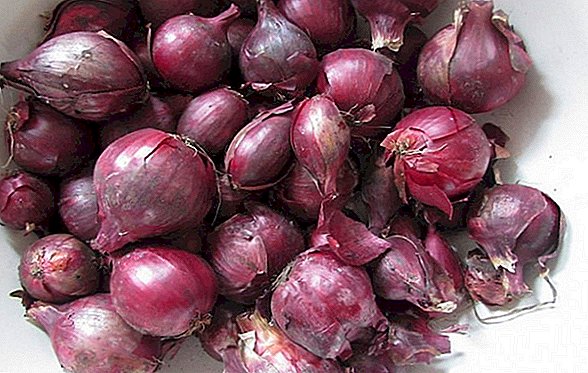
Important! It is not recommended to plant onions in areas with close groundwater storage.
The process of planting sevka in the ground
Planting onion sets carried out as follows:
- Soil for the day before planting need to moisten.
- Make on the soil surface grooves 4 cm deep and 30-40 cm wide row spacing.
- Dig the onions into the grooves at a distance of 5-8 cm from each other and sprinkle with a layer of earth 2-3 cm so that the tails stick above the surface.
- After 10-12 days, young onion greens should germinate.
Watering
The amount of water and the intensity of crop irrigation depend on the climatic conditions of the region and the abundance of precipitation. 
When watering onion sets, you must adhere to certain requirements:
- If there is high humidity in the area, then the bed is made high, with good drainage.
- At the initial stage, watering is carried out every other day. Then the onions are watered 1-2 times in two weeks at a temperature of from +20 to +28 degrees.
- In hot weather (above +30 ° C), the sevka needs watering every 7 days.
- At first, the water consumption for irrigation is 1 square meter. m - 10 l. Further, the water consumption decreases slightly.
- Watering onions is carried out only with warm water + 30 ... +35 degrees. To do this, place metal tanks at the site and fill them with water so that during the day it can settle and heat up in the sun.
- It is necessary to water the onions carefully, without strong pressure, letting water into the aisle to prevent water from entering the neck of the leaves.
- Onions on a feather watered on top of a garden watering can with a spray.
- During the rains, the culture is not watered in order to prevent its rotting due to high humidity.
Important! You can not carry out abundant watering of onions at the end of the growing season, as this will delay the maturation of the crop and reduce its capacity.
Soil loosening and weeding
Onions are a demanding crop to aerate the soil, and also he does not like the dominance of weeds. 
Therefore, the following measures are necessary:
- The next day after each watering you need to loosen the soil between the rows. This procedure is done shallowly so as not to damage the gentle roots of the set.
- If in the current season the weather with frequent rains, then loosening is made after each rainfall.
- Mandatory regular weeding from weeds, because they prevent the evaporation of excess moisture from the bed, and it threatens the development of fungal diseases and rotting processes in the bulbs.
Top dressing
Feeding is carried out two or three times per season according to the following scheme:
- 2 weeks after planting, nitrogen fertilizers (nitrophosphate, urea) are applied;
- 2 more weeks after the first procedure, the onions are fed with phosphorus-potassium fertilizer;
- after 15 days, you can again repeat the phosphate-potassium fertilizer.
After each fertilization the soil must be watered abundantly. Be sure to wash off the remnants of fertilizer with onion leaflets with warm water from a watering can. 
Pests, diseases and prevention
Like other onions, Carmen can suffer from the following pests:
- onion covert;
- onion flies;
- stem nematode;
- onion moth;
- root tick.
To avoid the appearance of uninvited guests, the culture must be processed from the moment of the first shoots by spraying with preventive means.
To do this, use the following fungicidal preparations:
- Glyocladin;
- "Fitosporin-M";
- "Alirin";
- "Hamair";
- solution "Zineba" (0.04 percent);
- copper oxychloride solution (0.5 percent);
- Bordeaux mixture.

During the growing season it is necessary to constantly monitor the condition of the plants, and if drying, pale color of feathers, their twisting or yellowing is detected, then the affected bulbs should be immediately removed.
Important! After treatment with pests it is necessary to refrain from eating onions for 2 days.
Harvesting and storage
Harvesting onions "Carmen" is carried out in late summer or early autumn.
To do this, the following steps:
- 30 days before the planned harvest, the onions are watered and the tops are folded to the ground. These actions will allow the turnips to germinate more.
- A suitable time for cleaning will be sunny and dry weather with a light breeze.
- After the feathers dry, the onions are removed from the soil. If the culture grew on light soil (loam, sandstone), then it is enough to take a turnip for the tops and carefully pull it out of the ground. On hard soil, the turnips dig in a shovel or pitchfork, slightly receding from the bulbs so as not to damage them.
- The soil from the bulbs is removed by hand, otherwise when tapping one bulb on another, damage will occur.
- Dug out turnips for 10 days leave to dry in the sun, under a canopy or in the attic, turning them over periodically.
- During cleaning, the heads are sorted: with a wide neck they are deposited and used first, the rest are prepared for long-term storage.
- After drying, the heads of the neck of the bulbs are cut, leaving a tail 5 cm long. You can braid the tops in a braid using twine for strength.
- The roots are cut with a sharp knife under the turnip bottom.
- It is impossible to overdry the bulbs too much so that the outer scales do not crack or separate - this will have a bad effect on the storage of the crop.

If the onion is removed from the highly moistened soil and it is not possible to dry it in the sun due to rains, it should be washed and cleaned from husks, tops and roots. Next, the heads are laid out to dry in a single layer in a well-ventilated room.
After three weeks, new scales form in a single layer on the bow. Such bulbs are stored in the same way as those collected in dry weather.
Braided vegetables are stored suspended. Bows with cut tops placed in boxes or containers. Crop is stored in cool and ventilated rooms with a humidity level of not more than 70% and air temperature not higher than +20 degrees and not lower than 0.
Shelf life of onion "Carmen" - 6 months, shelf life under the right conditions - 9 months.
Possible problems and recommendations
Bow "Red", like other varieties, may be affected by various diseases and parasites that destroy both feathers and heads. Preplanting planting material gives some protection, but errors in cultivation can trigger fungal diseases. 
In order to prevent the need to adhere to the following recommendations:
- planting material must not be taken from an infected household;
- mandatory preplant tillage and inventory with special tools ("Inta-Vir", "Aktara", "Iskra", "Thunder");
- during the growing season it is recommended to use pest-repellent drugs or plant insecticide plants (garlic, coriander, horseradish, celery, marigold, wormwood, tansy, nasturtium, etc.) next to an onion;
- strictly observe the rules of crop rotation;
- remove all plant residues from the site in the fall;
- carefully inspect the plots for the presence of pests and in time to destroy them with the help of special preparations.
There are also other problems when growing Carmen onions: yellowing of feathers and deterioration of the taste of the turnip (excessive bitterness).
In the first case, you need to establish the cause of yellowing greens. 
Here are some reasons:
- soil deficiency in nitrogen;
- onions are affected by pests or diseases;
- non-compliance with agrotechnical rules.
To fix the problems, you can apply the tips described above.
In the second case, the causes of bitterness can be the following factors:
- lack of phosphate fertilizers,
- increased soil dryness.
To make the vegetable grow less bitter, you need to follow the following guidelines:
- during the growing season to make increased doses of superphosphate;
- follow the schedule of watering, especially in hot weather.
In conclusion, let us say that by growing Carmen onions, one can get high yields with little material investment and effort. 
If you apply the proper crop culture techniques, then diseases and pests will not be intimidating to it, and you, in turn, will receive a vitamin product with good taste and long shelf life.


